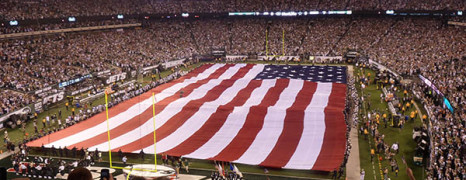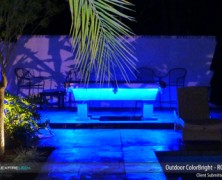When the Seattle Seahawks face off against the New England Partiots at this upcoming Super Bowl, LED stadium lighting will illuminate the field. Scheduled for Feb. 1st, the game will be the first NFL championship match that has ever been lit with LED lights. The LED lights were installed last fall at University of Phoenix Stadium. The Arizona Cardinals and San Francisco 49ers were the first to play a game on Sept. 21st, 2014 under the new lighting system. The LED stadium lighting will significantly increase the light on the field and will produce a more vivid picture on the screen for the 110 million plus expected viewers of this year’s game. The light will shine in a more uniform manner than the legacy system, creating less shadows and a clearer view of the action taking place on the field. Another advantage of LED lighting is the fact that they don’t flicker, which will lead to less distractions during slow-motion replays. There will be 312 LED fixtures installed to replace the 780 metal halide lights. The new LED stadium lighting will use just 380,000 watts compared to the 1.24 million watts needed to power the old system. Combined with savings generated for lower air-conditioning costs, most venues that choose LED stadium lighting enjoy a 75% reduction in overall energy consumption. Further, the system will age more gracefully than metal halide lights, which take on a reddish hue and lose brightness over the years. The University of Phoenix Stadium was originally opened in 2006. With its innovative design that includes a retractable roof and field, it’s recognized as one of the most advanced stadiums in North America in terms of its engineering. This multi-purpose facility previously hosted Super Bowl XLII in 2008. It also hosts the annual Fiesta Bowl, and numerous international soccer matches. The stadium seats 63,400 fans, but is expandable to seat 72,200. Questions? This Super Bowl Sunday will be lit by LEDs? Just another reason that Flexfire LEDs is excited about being a part of the future of LED lighting! If you have any questions about LEDs, and specifically LED strip lighting, remotes, and dimmers, please stop by our website at flexfireleds.com or give us a call at 1-844-FLEXFIRE (1-844-353-9347) to talk with one of our design specialists...
5 Different Ways To Use Color Changing Led Strip Lights...
posted by Flexfire LEDs
Flexfire LEDs ColorBright RGB Color-Changing Strips are popular for both home and commercial applications. In this post, we present you with five ideas for using color changing LED strip lights. Waterside Color Changing LED strip lighting Who doesn’t like spending time by the pool or the lake during warm summer nights? Color changing LED strips are great for this purpose because the changing colors will boost the mood of your gathering, be it among friends or family. Make sure that the lights are rated for outdoor use and that they are water resistant. Flexfire LEDs offers two choices for outdoor-rated color changing LED strips: ColorBright RGB 150 Outdoor strips and ColorBright RGB 300 Outdoor strips. The 300 RGB have double the amount of LED diodes per reel and produce twice as much light as the 150 RGBs. Living Room Color-Changing LED strip lighting Color changing LEDs in the living room are a great way to start a party, or set the mood on a date. Or to help you find your “happy place” after a stressful day at work. Did you know that light color has a significant effect on on our moods? That means putting color changing lights in the living room will give you greater control not only of your lighting environment, but also of your mental state. While many people come to us in their search for colorful lights, they would like a “white light” option as well. For these clients we suggest our ColorBright RGB plus Warm White strips. Using a remote, users switch between warm white setting and the RGB color-changing setting. The result of this amazing pairing is beautiful and allows for an unparalleled degree of personal customization. Stage Color-Changing LED strip lighting Most people write off strip lights for stage lighting purposes because...







